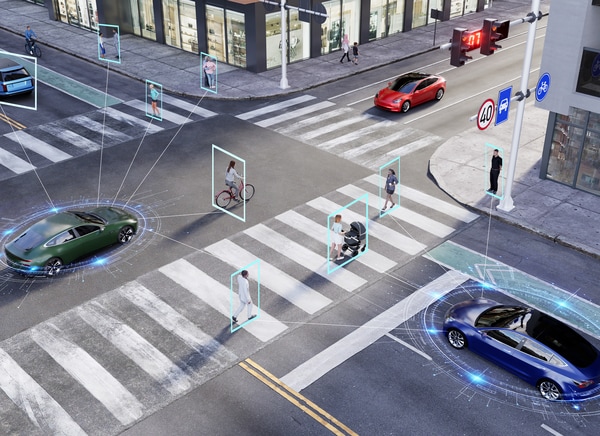The Blind Spot in Automotive Vision Systems

(Source: karelnoppe/stock.adobe.com)
Manufacturers of the latest vehicles, whether family cars or commercial transport, are deploying automotive systems to improve road safety. These advanced driver assistance systems (ADAS) combine familiar features like anti-lock braking with onboard intelligence to enhance the driver’s capabilities, and these systems are becoming more prevalent. It's no longer just the luxury brands that have access to adaptive cruise control, lane departure warnings, and pedestrian detection. Those features have entered the mainstream market.
ADAS also serves as a stepping stone to fully autonomous vehicles, where safety remains a major concern. Cameras are central to the deployment of ADAS technology. These vision systems do not just capture images; they provide a continuous flow of visual information to allow the onboard systems to perceive, understand, and react to their surroundings.
Automotive vision systems’ importance to safety can be seen in a simple scenario. A vehicle traveling at approximately 96.56 kilometers per hour (60 miles per hour) approaches an intersection when a pedestrian starts crossing the road. In an ideal situation, a forward-facing camera detects this movement, the onboard ADAS receives the camera's output, activating its braking logic to prevent an accident. At highway speeds, a millisecond corruption of data translates into meters of lost stopping distance. Those few meters could be the difference between stopping safely and a tragic collision.
The potential data corruption in this scenario is not caused by a failure in the camera. Instead, the failure is in the connection between the camera and the processor. A range of environmental conditions can cause such a disruption in transmission, from vibration and shock to electromagnetic interference. The automotive environment is one of the toughest in the world, with temperature extremes and constant mechanical stress. Designers must engineer for these harsh conditions to ensure data is never lost at the critical moment, and rugged connectors are vital to successful vision system designs.
This blog explores the role of dependable coaxial connectors in ensuring the safety of automotive vision systems, highlighting how robust connectivity underpins the performance of ADAS and autonomous vehicles.
Unprecedented Data
Today’s vision systems continuously receive immense amounts of data. This becomes a greater engineering problem as the amount of data is magnified by current camera technologies. A compact 8-megapixel camera can operate at up to 60 frames per second. Even when the signal is compressed, the output from such a camera is approximately 7 gigabits per second (Gbps). This figure multiplies quickly, as modern vehicles can be equipped with around ten such cameras to provide full panoramic imaging.[1] In some extreme cases, this number is even higher. ADAS functions must therefore handle a continuous flow of many tens of gigabits per second.
The data requirements of the latest fully autonomous prototypes are even higher. Vision is combined with radar and LiDAR systems to create data rates that rival or exceed enterprise-grade networks. The Automotive Edge Computing Consortium (AECC) has estimated that such vehicles generate between 0.4 and 5 terabytes of sensor data per hour.[2] The increased data demands of these cameras is shaping both in-car architecture and the broader automotive infrastructure, as vehicle-to-everything (V2X) systems share information to promote safety.
To work effectively, the perception systems within the car are designed to operate with ultra-low latency and near-zero tolerance for errors. A disruption of even a few frames can impact object recognition models. As displayed in the earlier scenario, even a brief delay in perception is unacceptable, which is why engineers must treat vision data transmission not as an IT problem, but as a critical safety matter.
Coaxial: The Backbone of Safety
Coaxial connectivity is now critical to the safety functions of ADAS and automotive camera systems. Unlike twisted-pair solutions, coaxial cables can reliably transmit multi-gigabit data rates over distances of several meters without the need for repeaters. This capability is essential as cameras become increasingly mounted around the vehicle, located far from central processing units (CPUs).
Coaxial technology also offers advantages beyond bandwidth. Many automotive designs are adopting phantom powering, in which both video data and electrical power can run over the same cable. With vehicle designers under constant pressure to add more functionality, using coaxial cables to provide power reduces both weight and cost while maintaining the performance required by vision systems. Coaxial cables also provide superior resistance to electromagnetic interference (EMI). This is even more important with the introduction of electric drivetrains, DC/DC converters, and high-frequency antennas, where high currents and high frequencies can create unwanted effects.
Coaxial technology is a proven solution for automotive vision. It combines high bandwidth with power capabilities and EMI resilience to maintain low latency and preserve signal integrity. The bigger risk, though, isn't in the cables themselves; it's in the connectors that terminate them.
The Weak Link
A poorly chosen connector can be the difference between dependable video transmission and corrupted data. The impacts of impedance mismatches, insertion loss, and reflection mean that careful design is a must. The vehicle is an unforgiving place for sensitive equipment, and poorly shielded connectors are the weak point that will allow interference to introduce errors into critical data streams.
The automotive environment has a direct physical impact on the safe operation of connectors. The continuous vibration experienced by connectors can create long-term damage from fretting corrosion. These micro-movements degrade performance significantly and, in extreme cases, cause intermittent or even permanent open circuits.
Mechanical stresses also impact connector performance. Automotive connectors must survive temperature extremes from –40°C to +125°C, while also sealing against dust, moisture, and contaminants. Even over years of vibration and constant temperature cycling, connectors must sustain their performance. Together, these mechanical, environmental, and electromagnetic challenges make connectors the most critical and vulnerable component in automotive vision systems.
Camera Connectivity Fit for Automotive
TE Connectivity (TE) has decades of experience in solving the problems of communicating in tough conditions. TE's coaxial product range reflects its depth of expertise. As vehicles move to higher levels of autonomy, connector performance has become more critical. TE’s automotive connectors are designed to deliver the necessary bandwidth while withstanding the vibration, heat, and EMI common in automotive environments.
For today’s advancing vision systems, TE camera solutions, including FAKRA, MATE-AX, and high-performance camera connectors, offer a robust portfolio of camera connectivity solutions.
TE’s FAKRA connector has been widely adopted across the industry due to its robust, standardized interface and ability to deliver multi-gigabit performance. TE’s extensive FAKRA portfolio connectors provide the shielding needed for safety-critical vision systems. For applications requiring high data bandwidth and even compacted design solution, the MATE-AX miniaturized coaxial connectors extend this capability. Supporting up to 9GHz, MATE-AX is engineered for high vibration resistance and can be sealed to IP67/IP69K as part of the proven AMPSEAL 16 connector system. With a characteristic impedance of 50 Ohms for compatibility with RTK031 and RG174 cables, the MATE-AXconnector system is used in applications beyond cameras, including telemetry, antenna, ECUs and V2X systems.
Conclusion
Automotive vision is more than merely high-resolution sensors and powerful processors. These are important, but neither can deliver the safety promised by ADAS without a secure link to connect them. The automotive environment presents a demanding combination of challenges that place extraordinary stress on equipment and infrastructure.
Coaxial cables and the connectors that join them are small, but their role is enormous. They determine whether every pixel captured by the camera arrives intact and on time. In a situation where milliseconds equal meters, this reliability can save lives. Engineering dependable connectors is every bit as critical as the design of sensors, processors, and algorithms.
Author
 David Pike is well known across the interconnect industry for his passion and general geekiness. His online name is Connector Geek.
David Pike is well known across the interconnect industry for his passion and general geekiness. His online name is Connector Geek.
Sources
[1] https://www.edge-ai-vision.com/2020/05/how-many-cameras-do-we-need-29-says-waymo/ https://www.nadimhossain.com/posts/7-hard-things-about-product-management-for-autonomous-vehicles-1/
[2]